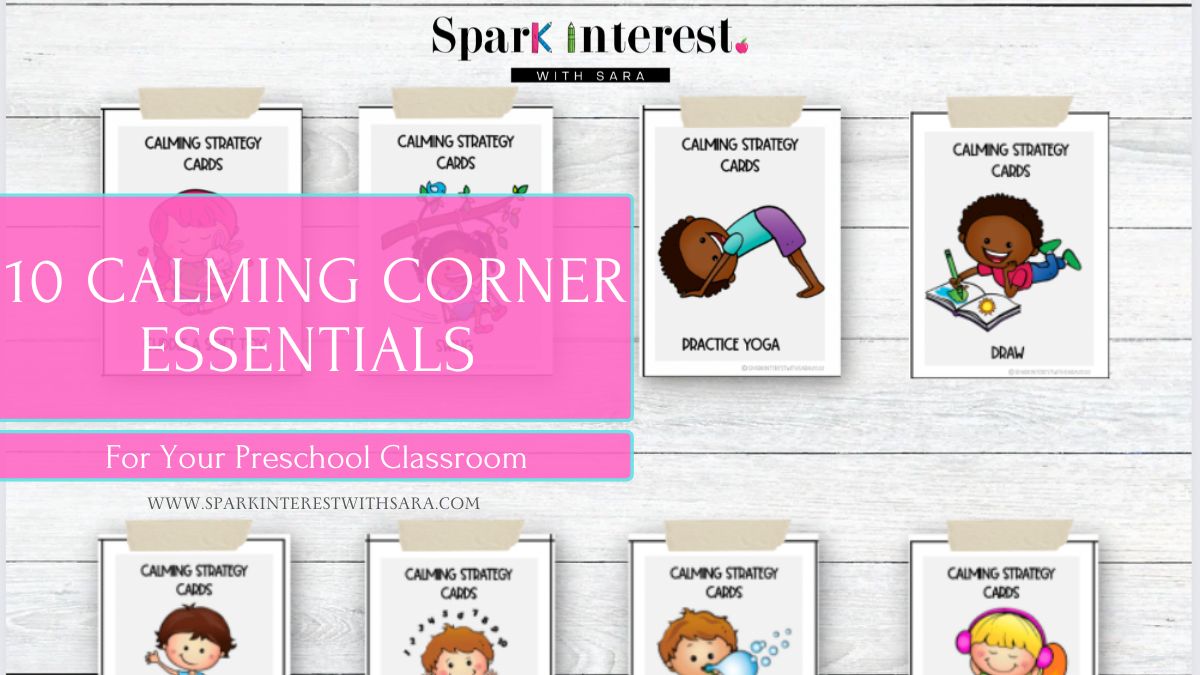
In the bustling world of preschool, we all know emotions can run high! In those moments, our young learners might need some support in regulating their emotions and that’s where a calming corner comes in.
This special space provides a haven for children to regulate their emotions, allowing them to pause, reflect, and return to the classroom ready to engage.
Are you thinking of including a calming corner or calm down area in your classroom? It has been a game changer in my classroom and I’m so happy you are exploring the idea of having one in your classroom too!
Just know that a calming corner is so much more than just a place students can go when they are upset.
In this blog post we are going to explore what a calming corner is, why it’s essential, when to use it, and how to make the most of this invaluable classroom resource.

What is a Calming Corner?
To keep it simple, a Calming corner is a designated area in the classroom equipped with materials and tools to help children manage their emotions. It’s a safe space where students can go when they need a moment to breathe and gather themselves. You can make it as simple or as creative as you want. Many times, you have everything you need right inside your classroom already to create a fantastic calming corner!
Learning to navigate emotions is a crucial skill for preschoolers. It sets the foundation for their social and emotional development, fostering empathy, self-awareness, and effective communication.
Reading books focused on self-regulation and allowing students time to practice these skills are great ways to start. However, providing a space where students are able to really put their mindfulness skills to the test is a great addition to a classroom.
A calming corner provides them a place they can go when they have ‘big feelings’ or need a safe space so that they can put into practice the skills you have been teaching them to manage their emotions.
Having a safe space like this in the classroom shows students that you care. Whether upset or overstimulated, a calming corner has all the needed materials to help them regulate their emotions so they can return to regular classroom activities when they are ready.
Other Calm Down Corner Names:
- Calm Zone
- Calm Spot
- Peaceful Place
- Zen Den
- Chill Zone
- Safe Space
- How about naming it after a relaxing place like Hawaii or Fiji
When to Use a Calming Corner
A calming corner should always be readily available to your students. It is a permanent spot in your classroom; students should know the location if they need to use it, and it should always be available to them.
The calm down corner should never “close” unless students need a refresher on how to use the materials, seating, etc. This corner serves as a special place for various situations, such as:
– A child feeling homesick
– A child struggling to settle in the morning
– A child upset about not getting something they desire
– Overexcitement after a class activity
Although these are just a few examples, the calm down area may be used for many other situations inside your classroom!
Calming Corner Rules
Like with introducing any area in your classroom, you’ve got to put some time into showing your students how to use the equipment, resources and furniture in the space.
We need to set expectations and ensure our students know what is appropriate and how they can make the most out of that special space in the classroom.
To ensure the calming corner is used effectively, establish some clear rules. Here are some examples:
1. Only one person at a time
2. Choose a calming strategy
3. Treat the resources in the space with care
4. No throwing things
5. Use quiet voices
6. Return to the group when calm and ready to refocus

How to Use a Calming Corner
Effectively implementing a calming corner in your preschool classroom is key to ensuring its success as a tool for emotional regulation. Following these practical steps will help create an environment where students feel empowered to navigate their emotions.
Step 1: Inclusivity
Ensure all students know they are welcome to use the calming corner, even if some use it more frequently.
Step 2: Emotion Identification
Teach children to recognize and label their feelings. Provide them with strategies to manage these emotions.
Step 3: Introduction
At the beginning of the school year or when you implement the calming corner, explain its purpose and when students can use it. Reinforce the rules.
Step 4: Introduce Tools Gradually
Present one calming tool or strategy daily until students know all available materials. This prevents overwhelming or cluttering the space.
10 Essential Items for Your Calming Corner
Setting up a calming corner in your preschool classroom is a thoughtful way to help children regulate their emotions. Ensuring it’s equipped with the right tools is key.
Here are ten essential items to consider for your calming corner, each carefully chosen to provide comfort and support for your students’ emotional well-being. Not all of these items need to be in there at once.
Just pick and choose what works best for where your students are at and switch them around as the year progresses.
- Music or Meditation Stories: Soft, calming tunes provide an auditory escape, promoting relaxation. Meditation audio stories are also an excellent resource to have in this area. Remember to include headphones, so that the experience remains personal and non-intrusive for other students.
- Sensory objects: Tactile experiences offer a tangible way for children to ground themselves, providing a soothing, hands-on outlet for their emotions. Squishy balls, play dough, and fidget spinners are often very useful in preschool.
- Soft seating: Creating a cozy, inviting space helps children feel at ease, encouraging them to spend quality time in the calming corner. Include items like bean bags and cushions.
- Visual aids: Engaging visuals offer a soothing focal point, aiding relaxation and redirecting focus away from overwhelming emotions.

- Soft toys or baby dolls for comfort and nurturing: Cuddly companions provide a sense of security and offer an opportunity for nurturing play, reinforcing a feeling of comfort and safety.
- Mindfulness coloring sheets or other mindful exercises that fit into the space: Mindful activities like coloring or simple breathing exercises promote focused relaxation, helping children find inner calm.

- Calming strategy prompts: These visual cues offer gentle reminders of techniques for self-regulation, empowering children to take charge of their emotional well-being.
- Books on self-regulation and empathy: Books can be powerful tools for learning and reflection, nurturing a child’s understanding of their emotions and empathy towards others.
- Yoga cards for gentle movements and breathing exercises: Incorporating gentle yoga movements and breathing exercises helps children connect with their bodies and breathe, promoting relaxation and mindfulness.
- Drawing and writing materials for creative expression: Providing artistic tools encourages self-expression, allowing children to process their emotions and thoughts constructively and calmly.
A well-prepared calming corner is a powerful tool in a preschool teacher’s arsenal. It fosters emotional regulation and communicates care and understanding to your students.
By following these steps and providing a range of calming resources, you’re creating an environment that supports every child’s social and emotional growth in your classroom.

Want to learn more? You might find these blog posts helpful:
7 Effective Strategies for Introducing Mindfulness
Books to teach self regulation
Let's Connect:

Sara
